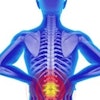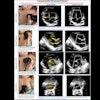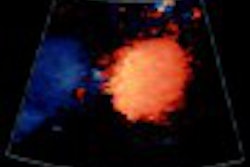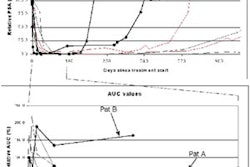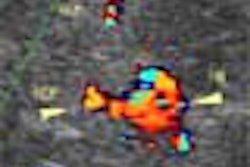For the simple reason that patients and ultrasound experts aren’t always in the same place, telesonography would seem to be a valuable tool. Ensuring success, however, requires adherence to standardized telesonography protocols and performance standards, according to Dr. Dolores Pretorius of the University of California, San Diego's 3-D Ultrasound Imaging Group.
To test the efficacy of telesonography, researchers from UCSD and Thomas Jefferson University in Philadelphia performed 2-D and 3-D ultrasound studies, sharing patient data between the institutions. Complete 2-D ultrasound sonograms and multiple 3-D ultrasound volumes were acquired for each patient.
The studies were performed following guidelines published by the American Institute of Ultrasound in Medicine (AIUM) of Laurel, MD. Two-dimensional ultrasound studies were read by a single reader at the institution where they were acquired, while the 3-D ultrasound exams were read by multiple readers at both sites.
The researchers concluded that offline review of 3-D ultrasound data was generally able to comply with AIUM/American College of Radiology (ACR of Reston, VA) guidelines. Reviewers were able to identify normal and abnormal findings on both 2-D and 3-D ultrasound studies.
The researchers attributed discrepancies on both exams to image-quality shortcomings, sonographer technique, and variable review protocols. For 3-D ultrasound, discrepancies reflected the use of individual review protocols, Pretorius said.
Acquisition
Because technical requirements for 3-D ultrasound acquisition and review differ from 2-D studies, it's important to properly train sonographers and physicians, and to standardize acquisition and evaluation, Pretorius said. High-quality images are mandatory, and it's crucial to acquire sufficient data to cover the organ.
Pretorius suggested these guidelines for training physicians and sonographers for telesonography:
- Train in acquisition, display, and interpretation of volume data.
- Train to evaluate patient anatomy and pathology.
- Train to include pertinent details on the clinical history form.
- Train in standardized protocols for acquisition and review of volume data.
- Train to use standardized reporting terminology at all participating institutions.
- Train to recognize artifacts that occur due to acquisition, review, and editing.
For volume data acquisition, the clinical history form should be filled out at the time of the study, she said. Specific transducers should be selected for specific organs of interest, and a real-time 2-D localizing scan should be performed prior to 3-D to evaluate patient anatomy and determine the appropriate volumes that are needed, she said.
Volumes should be acquired using standard orientation for each organ or structure. It's important to meticulously acquire sufficient data to completely image the volume plus landmarks, she said. Patients need to hold their breath during acquisition.
Anatomic orientation must be properly labeled, she said.
"You must know the anatomic orientation, because if you give me a (3-D image of the) ovary, there's no way I know if it's right or left, because I can turn it and twist it in every different direction, and I need to know the clinical signs," she said.
Any motion or pain should be included on the clinical data form, Pretorius said. After volume data acquisition, the sonographers should perform a preliminary review to verify completeness, quality, lack of motion, and freedom from artifacts or distortions.
Volume should be reviewed in the plane of acquisition to determine if adequate volume was obtained. Volume should also be reviewed in the re-sliced plane to verify proper aspect ratio, lack of patient motion and artifacts, and presence of abnormalities, she said.
Pretorius recommends acquiring at least two volumes from different orientations for abnormal structures and targeted areas of interest when an abnormality is suspected. The entire organ of interest should be acquired, with the use of multiple volumes as required, she said.
A standard sequence should be employed to acquire multiple volumes, with each volume labeled in relationship to other volumes, she said. Overlap should be included between volumes, especially landmarks, she said. Data volumes then need to be archived in an anatomically consistent fashion with labels.
Image review
Of course, standards should also be applied to ensure consistency during the review process. The same standardized review protocol should be utilized at all locations, Pretorius said. A separate protocol should be used for each study, delineating the specific views to be obtained, the types of images, and the reporting terminology.
A standardized review procedure could include the following steps:
- Orient volume to standard anatomic presentation.
- Scroll through volumes from several orientations.
- Review all volumes before performing targeted review.
- Perform organ-by-organ analysis using checklist.
- Re-slice or render as appropriate.
- Identify/label key anatomic landmarks.
- Identify/resolve artifacts in volumes and images.
- Verify anomalies in more than one volume.
- Verify anomalies in rendered images and slices.
- Verify orientation and labeling to avoid disorientation.
- Perform measurements as appropriate.
Images should be archived with the volumes, with other data recorded on a clinical history form. It's also wise to bookmark or save key images and volumes, showing normal anatomy or abnormal findings, she said.
"You don't want to have to go back through … and spend a lot of time looking at every volume," she said. "We need to bookmark those pictures, or we're not going to be fast enough interpreting these images, whether they're normal or abnormal."
By Erik L. Ridley
AuntMinnie.com staff writer
July 8, 2002
Copyright © 2002 AuntMinnie.com

